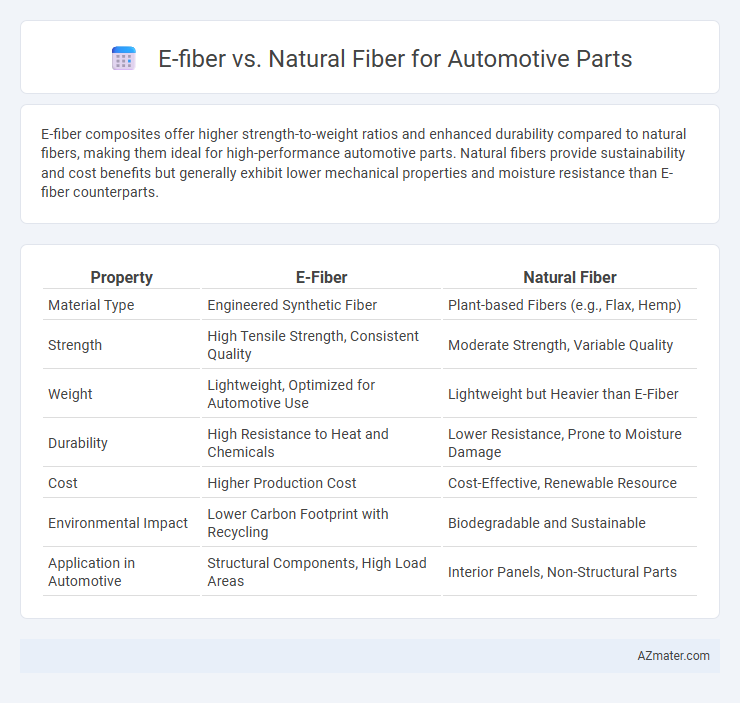E-fiber composites offer higher strength-to-weight ratios and enhanced durability compared to natural fibers, making them ideal for high-performance automotive parts. Natural fibers provide sustainability and cost benefits but generally exhibit lower mechanical properties and moisture resistance than E-fiber counterparts.
Table of Comparison
| Property | E-Fiber | Natural Fiber |
|---|---|---|
| Material Type | Engineered Synthetic Fiber | Plant-based Fibers (e.g., Flax, Hemp) |
| Strength | High Tensile Strength, Consistent Quality | Moderate Strength, Variable Quality |
| Weight | Lightweight, Optimized for Automotive Use | Lightweight but Heavier than E-Fiber |
| Durability | High Resistance to Heat and Chemicals | Lower Resistance, Prone to Moisture Damage |
| Cost | Higher Production Cost | Cost-Effective, Renewable Resource |
| Environmental Impact | Lower Carbon Footprint with Recycling | Biodegradable and Sustainable |
| Application in Automotive | Structural Components, High Load Areas | Interior Panels, Non-Structural Parts |
Introduction to E-Fiber and Natural Fiber in Automotive Parts
E-fibers, such as glass and carbon fibers, offer high strength-to-weight ratios and excellent durability, making them ideal for automotive parts requiring enhanced performance and longevity. Natural fibers like flax, hemp, and jute provide sustainable alternatives with low density and good vibration damping properties, contributing to lighter and eco-friendly automotive components. The integration of e-fibers and natural fibers in automotive parts balances mechanical strength with environmental benefits, supporting lightweight design and reducing overall vehicle emissions.
Material Composition and Properties
E-fibers, typically made from glass or carbon, offer superior tensile strength and durability compared to natural fibers like flax or hemp commonly used in automotive parts. The material composition of E-fibers provides enhanced resistance to heat, moisture, and chemical exposure, making them ideal for high-performance applications. Natural fibers, while biodegradable and lightweight, generally exhibit lower mechanical properties and are more susceptible to environmental degradation in automotive environments.
Manufacturing Processes and Techniques
E-fiber composites in automotive parts benefit from advanced manufacturing processes such as resin transfer molding (RTM) and automated fiber placement, enabling precise control over fiber orientation and higher consistency in part quality. In contrast, natural fiber composites often rely on compression molding or injection molding, which accommodate variable fiber properties but may result in lower mechanical performance and dimensional stability. Optimizing process parameters like temperature, pressure, and curing time is crucial for both materials to enhance bonding, reduce void content, and achieve desired strength-to-weight ratios in automotive applications.
Mechanical Strength and Durability Comparison
E-fiber composites exhibit superior mechanical strength and impact resistance compared to natural fiber counterparts, making them more suitable for automotive parts requiring high durability. Natural fibers such as hemp or flax offer lower tensile strength and are more susceptible to moisture absorption, which can degrade mechanical properties over time. The enhanced durability of E-fiber composites contributes to longer service life and improved performance under dynamic loading conditions in automotive applications.
Weight and Fuel Efficiency Impacts
E-fiber composites in automotive parts significantly reduce vehicle weight compared to natural fibers, leading to enhanced fuel efficiency due to lower energy consumption during operation. The lightweight nature of E-fibers contributes to improved acceleration and braking performance, while natural fibers, though sustainable, often increase part weight and negatively affect fuel economy. Optimizing the use of E-fiber materials supports manufacturers in meeting stringent emissions regulations by reducing overall vehicle mass and fuel consumption.
Environmental Sustainability and Life Cycle Analysis
E-fibers, derived from recycled or bio-based materials, significantly reduce the environmental footprint in automotive parts compared to traditional natural fibers like hemp or flax, which require extensive agricultural resources. Life Cycle Analysis (LCA) reveals that E-fibers offer lower greenhouse gas emissions and energy consumption throughout production, use, and end-of-life disposal phases. The durability and recyclability of E-fibers contribute to a more sustainable automotive industry by minimizing waste and promoting circular economy principles.
Cost Considerations and Economic Viability
E-fibers, such as carbon and glass fibers, typically involve higher material and processing costs compared to natural fibers like hemp or flax, impacting the overall budget for automotive parts. Natural fibers offer economic advantages due to lower raw material prices, renewable sourcing, and reduced energy consumption during production, enhancing their cost-effectiveness for large-scale applications. The choice between E-fiber and natural fiber depends on balancing performance requirements with long-term cost savings and sustainability goals in automotive manufacturing.
Performance in Real-World Automotive Applications
E-fiber composites offer superior strength-to-weight ratios and enhanced durability compared to natural fiber alternatives in real-world automotive applications, leading to improved fuel efficiency and vehicle performance. Natural fibers provide cost-effective and sustainable options but often face challenges related to moisture absorption and lower mechanical strength under dynamic driving conditions. Optimizing matrix-fiber interactions in E-fibers ensures consistent performance, making them preferable for critical structural automotive parts subjected to high stress and temperature variations.
Future Trends and Innovations in Fiber Materials
E-fiber technology is rapidly advancing with enhanced strength-to-weight ratios and improved recyclability, positioning it as a key material for next-generation automotive parts aimed at reducing vehicle weight and emissions. Innovations in bio-based E-fibers derived from sustainable resources are emerging to complement or replace traditional natural fibers such as hemp, flax, and jute in composite applications. Future trends indicate a convergence of hybrid composites combining E-fibers and natural fibers to optimize durability, cost-efficiency, and environmental impact in automotive manufacturing.
Conclusion: Choosing the Right Fiber for Automotive Parts
E-fiber composites offer superior lightweight properties, enhanced corrosion resistance, and improved durability compared to natural fibers, making them ideal for high-performance automotive applications. Natural fibers provide sustainability advantages, cost-effectiveness, and lower environmental impact but may lack the mechanical strength required for structural components. Selecting the right fiber depends on balancing performance requirements, environmental goals, and cost constraints specific to the automotive part's function.

Infographic: E-fiber vs Natural fiber for Automotive Part
 azmater.com
azmater.com